Palitoy was a British toy manufacturer that made Star Wars action figures and vehicles during the original trilogy's release—the Star Wars toy line of 1978, The Empire Strikes Back toy line of 1980, and the Return of the Jedi toy line of 1983—as well as 1985's The Power of the Force toy line. Based in Coalville, Leicestershire, where hundreds of employees designed, tested, manufactured, and packaged many of the Star Wars toys, Palitoy contracted various manufacturers in Hong Kong to produce a bulk of the toy lines' action figures for both itself and its American sister company, Kenner.
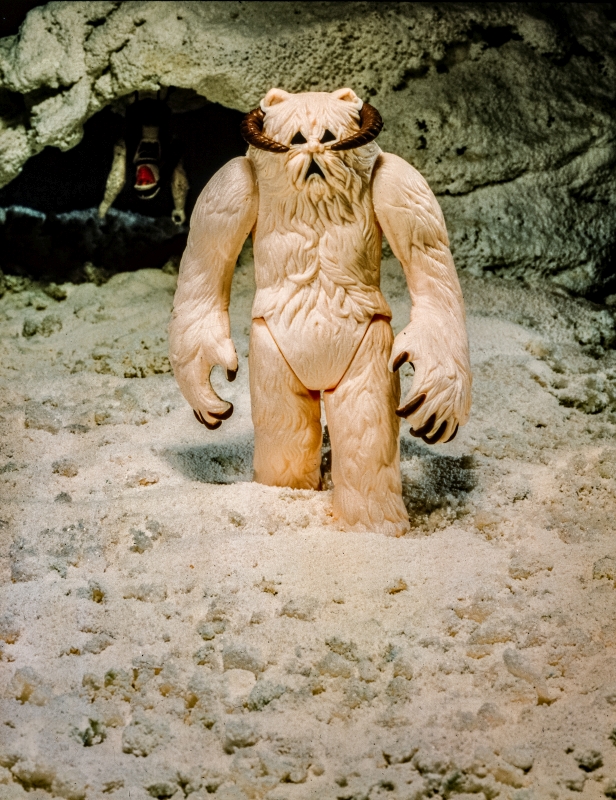
From soap containers to the wampa action figure (pictured), Palitoy's history was embedded in the town of Coalville and reached a global scale.
Founded in 1919 by the eighteen-year-old Alfred Edward Pallett as a small plastics manufacturer named Cascelloid making soap containers for the retailer Woolworths, Palitoy became the United Kingdom toy company that manufactured and distributed Star Wars action figures during the release of the original trilogy between 1977 and 1983. It was the British sister company of Kenner, the United States Star Wars toy manufacturer, and both companies were part of the CPG Products Corp. and owned by the American conglomerate General Mills. Palitoy had its factory in the Leicestershire town of Coalville in England. Both Palitoy and Kenner outsourced much of their production to manufacturers in Hong Kong, a city in Asia that remained a British colony until its sovereignty was transferred to the People's Republic of China in 1997.
Heading his own company, Star Warss director, George Lucas, had negotiated with the film distributor 20th Century Fox for exclusive merchandising rights to fund his future works. On behalf of Fox's licensing, Mark Pevers negotiated with Kenner executive Bernard "Bernie" Loomis for Star Wars action figures and vehicle models, and the deal was signed at The Century Plaza Hotel in Los Angeles on the same day that Loomis met Steven Spielberg, director of Close Encounters of the Third Kind and a friend of George Lucas, who remarked that Star Wars was "toyetic"—Loomis' term for being expressible in playable figure. Kenner decided that their toys for the The Six Million Dollar Man television series would be made by Palitoy's sister British manufacturer Denys Fisher under General Mills while Palitoy would produce toys for the Star Wars film, with Loomis persuading Palitoy to take on the Star Wars range for sale directly to retailers. Loomis also negotiated for Palitoy to have access to Kenner's marketing material and data, including their manufacturing sites in Hong Kong. Alongside George Lucas, Loomis reviewed the Star Wars script with other executives and engineers, including Karl Wojahn and Jacob R. Miles III, to discuss how their toys should be made. Kenner's Jacob R. Miles III was focused on developing toyetic X-wing and TIE fighter models, and he subsequently traveled to Hong Kong to find suitable manufacturers.
Palitoy was managed by Bob Simpson, who had worked his way up the company after relocating from Scotland in the 1960s and previewed the first Star Wars film in 1977—Simpson was awed by such a "toymaker's dream" after Kenner had negotiated a toy deal with George Lucas. Palitoy marketing director Lesley John Cooke was initially skeptical of selling Star Wars alongside Palitoy's flagship "Action Man" toy—the British version of G.I. Joe by the American toy company Hasbro—but was persuaded otherwise by Bernie Loomis after watching the film. Palitoy marketing manager Geoff Maisey also heard that Lucas intended to make a trilogy of films and told chief designer Bob Brechin to preview the film. Brechin was amazed by its designs and was sent by his boss, Bill Pugh—who was inspecting Palitoy's productions in Hong Kong—to visit Kenner and Hasbro in the United States.
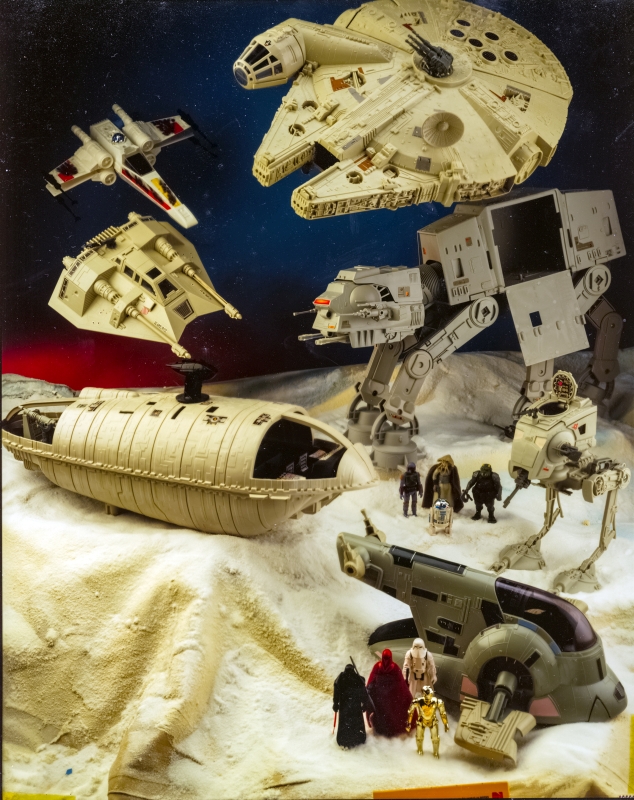
British Star Wars vehicle models involved both Kenner designs and original Palitoy designs.
As Palitoy's design and development director, Bill Pugh received a letter from Kenner dated September 27, 1977, inviting Palitoy staff to Kenner's headquarters in groups of two. The letter proposed Les Codrington and Alec Longton to visit first at the start of November while Brechin and tooling manager Roger Morrison would visit in the third week of the month, when Howard Bellinger and Jack Holland of Kenner would be available. In Cincinnati, Ohio, Brechin and Morrison saw Kenner's development of the landspeeder, X-wing, and TIE fighter models. In Detroit, they met Fundimensions, another General Mills subsidiary, which would make die-cast Star Wars toys for Palitoy to distribute. The pair requested Kenner to send moulding sets to the Coalville factory's moulder, Hardwick-Wood, as well as sending Palitoy landspeeder duplicating aids for usage in the French city Calais, where the General Mills–owned Meccano brand had a factory.
British retailers were initially skeptical of Star Wars as Palitoy only had resin models and photographs when trying to secure buyers for the new toys, and the retailers were offered Palitoy's popular Action Man toys at discounted prices if they bought Star Wars figures as well. The Star Wars film did not premiere in the United Kingdom until its central London debut on December 27, 1977 and other locations in January and February in 1978.
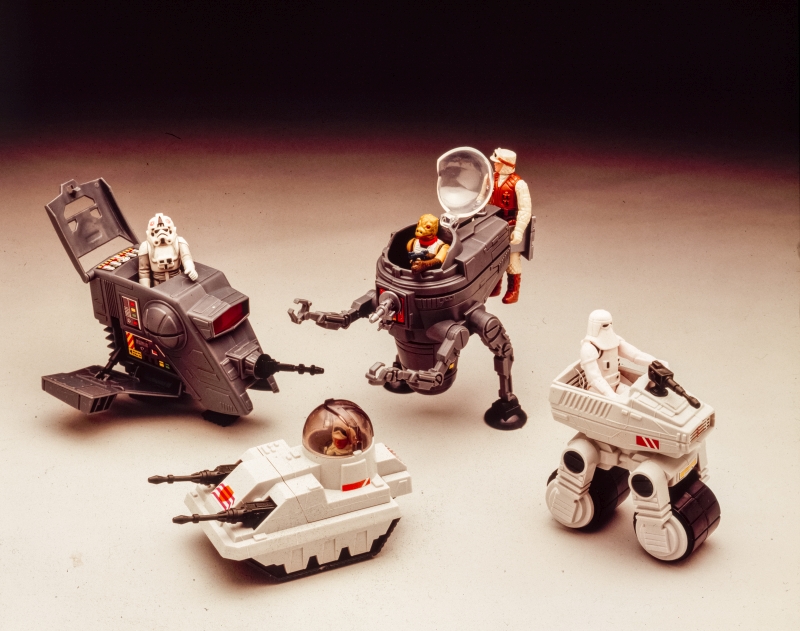
Palitoy made action figures and original vehicle designs based on the Star Wars films.
Sales manager John Nicholas remembered how he had received Palitoy's biggest order—a million Star Wars figures—from one retail chain half an hour after gifting its buyer a bottle of Scotch whisky. Surprised by the order, Nicholas subsequently replied "Oh, is that all?" to the retail chain Woolworths' order for 100,000 figures. The company's sales reached £20 million in 1978 (the equivalent of nearly £144 million in 2024) and sold 20 million figures in the UK by the time of Return of the Jedi's release in 1983. Palitoy made its own prototypes, using carved wood to create R2-D2 in the design process of a "talking" model, and prepared the first three vehicle models based on Kenner's blueprints but borrowed their injection moulds when they were available. Palitoy also produced smaller vehicles named Mini Rigs. As Palitoy's display manager before switching to Brechin's design team, Brian Turner set up Star Wars toys alongside other products at toy fairs in Birmingham and Harrogate to promote the new line, attracting children and media attention. An eager American showed off a "Force Beam" lightsaber at a nearby Cliro Perfumeries stall selling Star Wars bubble bath bottles, which captivated the crowd.
Across the Atlantic, Bernie Loomis deemed the "unsafe plastic tube" lightsaber knock-offs to be a threat, given that Star Wars release on May 25, 1977, in the United States did not allow enough time for action figures to be produced by then. Loomis pushed Kenner to make an early bird gift certificate program targeting parents with paper-made diorama sets, promising buyers that they would receive the action figures themselves in their mail by May 1978.
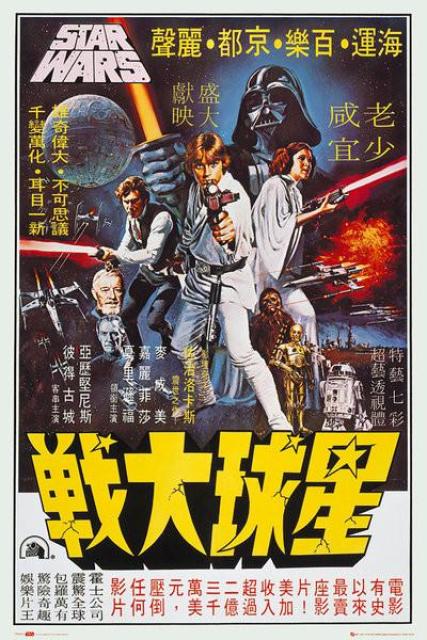
Palitoy produced Star Wars toys in Hong Kong (local film poster pictured).
A bulk of Palitoy's Star Wars products were manufactured overseas in Hong Kong as part of the British company's arrangement with Kenner. Kenner's Jacob R. Miles III assessed manufacturers in Hong Kong, including those in the colony's New Territories, for their moulding and tooling capabilities. Miles persuaded with some difficulty suitable factories to agree on mass producing toys for the as-yet unknown film—Star Wars premiered across Hong Kong on January 26, 1978. While Palitoy had been involved in Hong Kong since 1963, a company named Palitoy (Far East) Limited was incorporated on January 4, 1977, and it was renamed G.M. Products (Hong Kong) Limited on May 19, 1978, with the addition of the Chinese name 至美(香港)採辦有限公司 on November 23, 1982. Based in the newly opened Ocean Centre on the Kowloon Peninsula, Palitoy (Far East) Ltd. was formally founded on May 2, 1977 and included all the former employees of Symons & Co. Ltd., which was Palitoy's shipping agents firm in Hong Kong with the business magnate Li Ka-shing's Cheung Kong Industries Ltd. factories, which produced Palitoy's Action Man.
Palitoy Star Wars figures were made by the Hong Kong manufacturer Kader (開達實業), which also made Mainline Railways models for Palitoy. "LT" Lam Leung's Forward Winsome Industries Ltd (永和實業) also manufactured Star Wars toys. It had factories in both Hong Kong and Taiwan and had its first original equipment manufacturing (OEM) contracts at the time with Palitoy. Although Leung missed out on the contracts for G.I. Joe to Li Ka-shing, Forward Winsome fulfilled smaller orders and rode on Hong Kong's post-war migration and industrial boom and was based in the Eltee Building of the Chai Wan area on Hong Kong Island.
Forward Winsome was commissioned by Palitoy for a wide range of products and drew on the expertise of graduates largely from Hong Kong Polytechnic. While final assembly and packaging was always done in Chai Wan for direct quality control, the company outsourced the manufacturing of some components in early OEM film franchise contracts to other factories, including in the relatively far away New Territories of Hong Kong.
OEM contracts involved complying with additional safety regulations and upgrading technical processes, including restrictions on the common practices of child labor and working overtime; many laborers completed products in their own home, akin to a cottage industry. Forward Winsome's designs were based on blueprints from the original productions, and subsequently, the manufacturer made hand samples according to Palitoy's size specifications. After corrections and approval, Forward Winsome made the moulds and produced, packaged, and exported the figures. The company's contracts with Palitoy paved way for further OEM deals with toy corporations such as Hasbro, whom Forward Winsome had traded with since 1962.
In addition to Hong Kong, some Palitoy figure components were from nearby territories: the neighboring city and Portuguese colony Macau, self-ruled Taiwan, and Communist-ruled mainland China. Some Palitoy products were also labeled with France or Mexico as their origin, while Hong Kong and Taiwan action figure parts were sometimes combined. The Australian distributor Toltoy's packaging and figures were labelled as "Made in Hong Kong" and "Made in Taiwan," though some stickers specify the latter country's full name as "Made in Taiwan, Republic of China." Some of Toltoy's boxed sets were also made in New Zealand.
While Palitoy distributed Star Wars toys on Britain and Ireland, elsewhere in Europe, Star Wars toys were distributed by the General Mills branch and, by 1983, Parker in the Federal Republic of Germany (West Germany), PBP/Poch in Spain, Miro Meccano in France, Clipper in Belgium and Luxembourg, Harbett in Italy, Bria/Playmix in Scandinavia. In Australia, New Zealand, Malaysia, and Singapore, Star Wars figures were distributed by the General Mills Creative Products subsidiary Toltoys, with the Australian company attributing its license to Lucasfilm via Kenner, Palitoy, or the general CPG Products Corp. depending on the product. In Mexico and Brazil, the toys were respectively distributed by Lily Ledy and Glasslite.
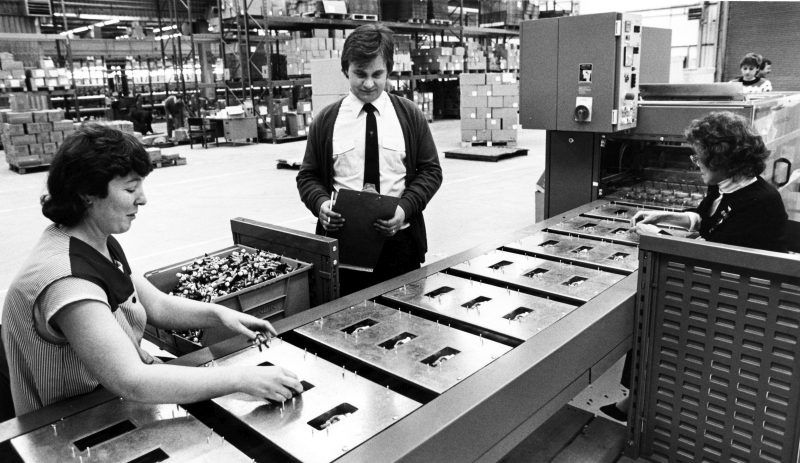
Palitoy employees packed Star Wars figures in Ashby-de-la-Zouch.
In the town Ashby-de-la-Zouch, Leicestershire, Palitoy had a packaging, storage, and distribution warehouse of five million cubic feet for their finished Star Wars toys.
Some Star Wars figures were sold by street traders in the United Kingdom before Palitoy officially released them in March, 1978, such as in Romford, London. Palitoy marketing manager Geoff Maisey alleged that it was due to opportunistic American and Hong Kong distributors shipping surplus Kenner-branded stock from Hong Kong to Britain, given that there was less demand for Star Wars merchandise in the rest of Europe. There were mostly figures and landspeeder models, as the X-wing and TIE fighter kits were larger. In 1983, a Palitoy produced a promotional Ewok figure was included with UHU gluesticks in Italy.
Employing teenage girls on the production line and paying each person according to the number of products they made, Palitoy not only assembled action figures and large Millennium Falcon models but also redesigned Kenner's plastic Death Star model as a cheaper and more interactive printed card toy. It was designed by Dave Barnacle. Palitoy also released the "Destroy Death Star" board game that was based on the 1976 Salvo! Palitoy Parker board games—as a subsidiary of General Mills, Parker Brothers made some of the first Star Wars board games in Canada, some of which were distributed by Kenner, and the first Star Wars video games. The board of General Mills and the Kenner president, Joe Mendelsohn, made annual visits to Palitoy to review product and financial plans.
With the release of the second film, Star Wars: Episode V The Empire Strikes Back, in 1980, Palitoy's All Terrain Armored Transport (AT-AT) toy cost £1 million and eighteen months to develop, and their Coalville factory employed 600 workers, with an additional 400 workers in the pre-Christmas period due to high demand. Palitoy employees recalled the atmosphere in Coalville making Star Wars toys as hectic due to the tight schedules. A visiting BBC Newsnight team described Coalville as "a goldmine on top of a coalmine," and Palitoy won the "Toy of the Year" award for their Star Wars figures and models in 1982 and 1983.
General Mills had acquired the British manufacturer Airfix and placed it under Palitoy's control, with Airfix deriving Star Wars kits from the American General Mills subsidiary Model Products Corporation (MPC). Star Wars MPC kits were also made by Denys Fisher but Palitoy declined the offer to distribute them, insisting that their Star Wars products were specialist rather than mainstream goods. Denys Fisher thus made Star Wars model kits, bob bags, and soft toys.
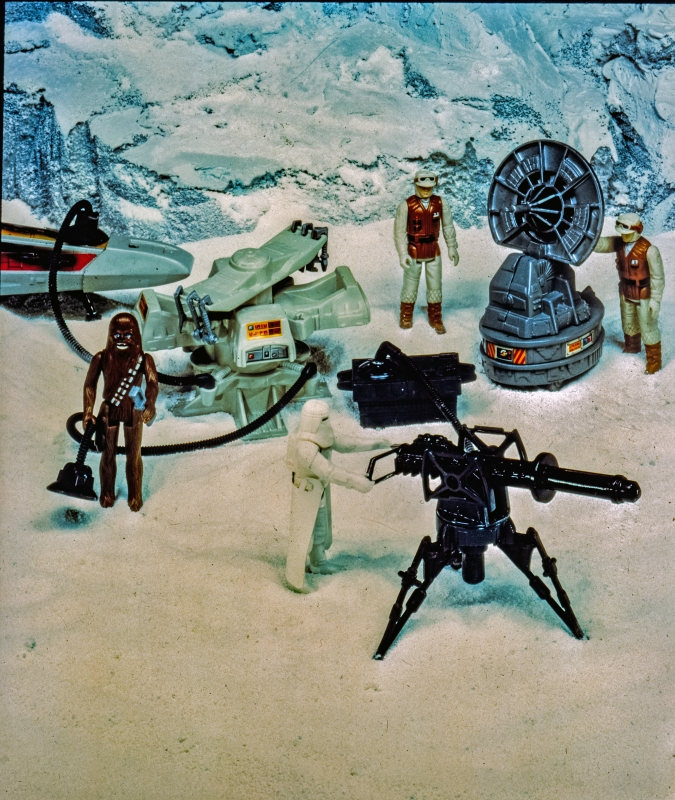
Palitoy Star Wars figures had compatible accessories.
Players could build their own display arena with larger "L"-shaped display stands, which included four paper backdrops of film stills from the original Star Wars and The Empire Strikes Back. In 1982, the display arena promotion was printed on the back of Hong Kong–made Star Wars action figure cards that bore the Kenner logo and proof-of-purchase seal but were imported to the UK. A sticker bearing the UK "display arena" offer—with the same name-and-price requirements as the previous "display stand" offer—obscured the United States display arena offer details, which required ten action figure seals and $2.
Similar offers existed for the Hong Kong–made 4-LOM and Admiral Ackbar figures in the same year. Kenner required five proof-of-purchase seals but no extra money for 4-LOM, specifying that the postage fee would be refunded; the offer was valid in the United States except for Washington and other states with taxation laws or other regulations on such offers. Palitoy's 4-LOM required five nameplates and 14p for postage.
Between the late 1970s and early 1980s, tokens collected from Star Wars toy packaging could be mailed to Palitoy in exchange for mystery figures encased in white boxes. 1980 posters and comic column advertisements promoted a free Boba Fett action figure in exchange for three Palitoy Star Wars figures' nameplates with signed retailers' receipts, 20p for postage and packing, and an address in the United Kingdom or "Eire"—Éire, the Republic of Ireland. To receive an action figure of Dengar, three nameplates were required to be cut from the toy packaging and stuck to the "Bounty Hunter Capture Log"—a 1981 promotion instructions leaflet included in playsets and provided by retailers featuring a Boba Fett illustration, with a segment for the customer to include their name, address, and age to be mailed away—in addition to 30p for postage and packing. For one extra name, a customer could receive a Luke Skywalker figure and survival kit—including a dozen accessories.
Receiving "Darth Vader Collector's Case"—which carries thirty-one Star Wars figures and was marked at a retail price of £14—required six character names and £7. An advertisement specified that the offer would last until December 31, 1981, and was only available to "UK and Eire" (Ireland) customers. Palitoy similarly offered four action figure display stands for four character names and £2.50, promoted on a flyer. The stands included four paper backdrops of film stills printed on both sides, giving eight scenes in total.
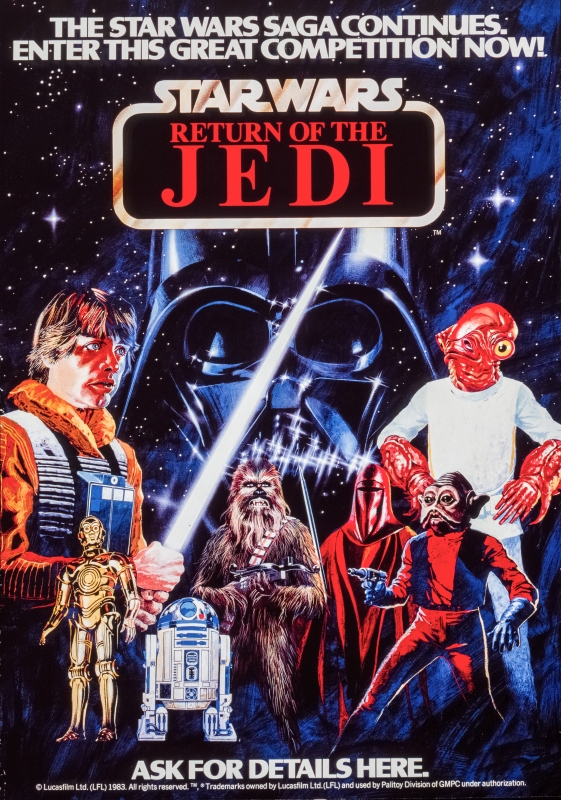
A British Palitoy poster advertising a competition for Return of the Jedi toys
Palitoy additionally created non-canon comic strips to advertise its products—featuring the Palitoy Cantina, the Palitoy Droid Factory, and the Land of the Jawas for the first Star Wars film—and various television advertisements in the UK. A single-page comic loosely adapting the events of The Empire Strikes Back was also published to promote Palitoy's figures and playsets. A later advertisement published in non-Star Wars comic titles called for readers to draw and name a new Star Wars bounty hunter—with no other instructions—to enter a competition to meet the stars of the upcoming Revenge of the Jedi film at Elstree Studios, Hertfordshire, while a hundred runner-ups would receive Star Wars Mini Rigs.
Palitoy wanted to show ten-second film clips followed by a twenty-second segment displaying their toy products, but the idea was rejected by the Advertising Standards Authority as the products do not function as shown on the film. Palitoy therefore storyboarded the toy showcase in accordance with the film sequences to demonstrate that playing with the toys could replicate the film scenes and was allowed to include them in their advertisements for 1980's The Empire Strikes Back and 1983's Return of the Jedi.
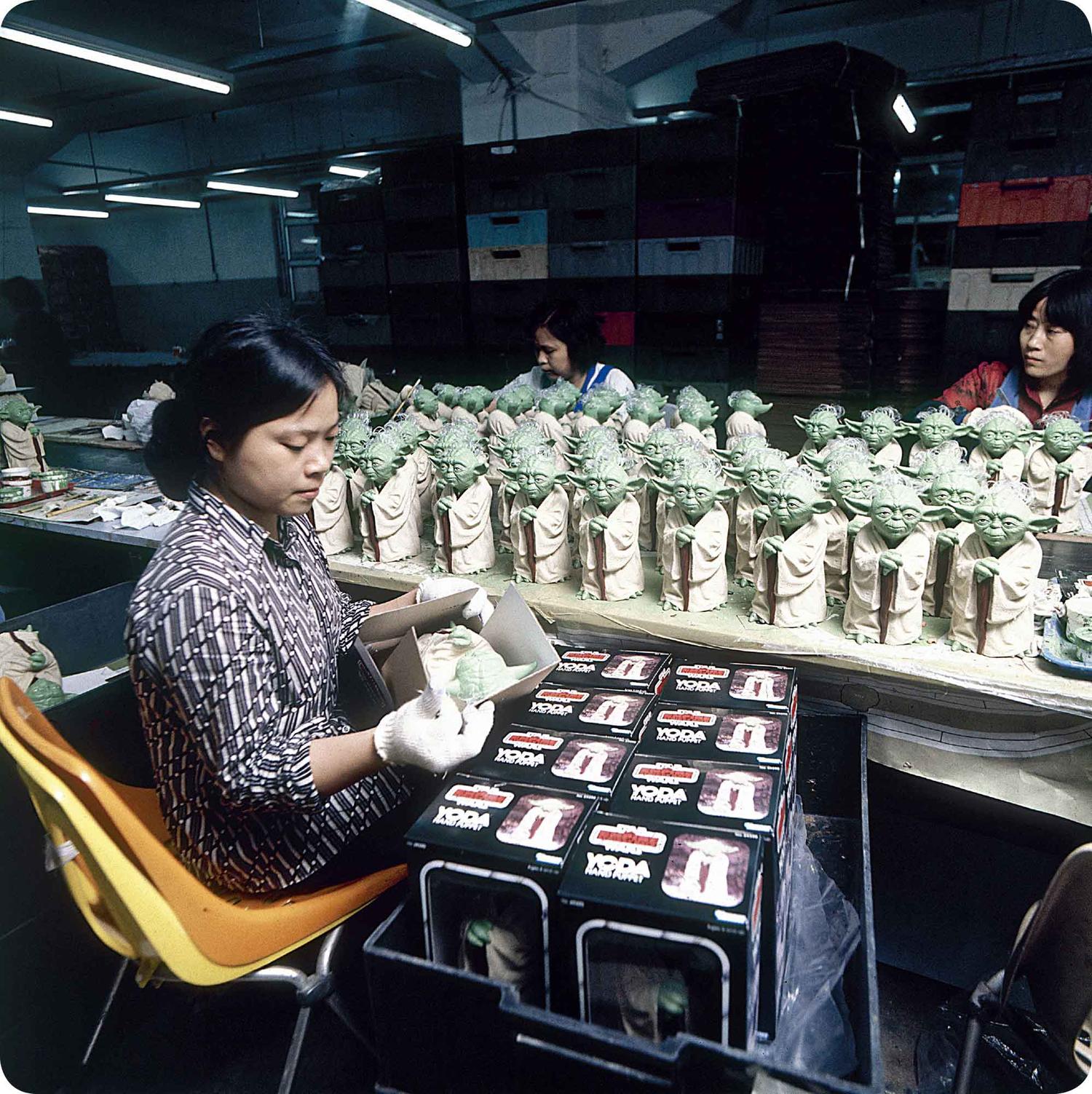
Palitoy and Star Wars figures boosted Hong Kong's plastic industry.
Hong Kong–made figures, which were not only limited to action figures and included larger Yoda hand puppets, were also exported to the United States and distributed by Kenner. The American company hired the Hong Kong manufacturer Smile Industries (堅達實業) to make its Star Wars toys, having done the same for The Six Million Dollar Man. In addition to its factory in Macau, Smile expanded its operations into the nearby city of Dongguan, Guangdong, in mainland China due to the surge in toy demands with The Empire Strikes Backs release in 1980 coinciding with China's economic opening up. It solved the capacity issue of 500,000 cloaks being needed for the Yoda figure in Hong Kong.
Similarly, Forward Winsome began gradually moving operations into mainland China in 1979, though the Communist state had few Western cultural imports in the 1970s and 1980s as it was still recovering from the Cultural Revolution. Star Wars toys were also made by the manufacturer Qualidux Industrial Company Limited (廣達實業), which has been based in Aberdeen on Hong Kong Island but moved productions across to mainland China as well. Both Qualidux and Kader were headed by Dennis Ting, whose family had set up factories in Taiwan but experienced rising labor costs on the island, with Kader opening its first mainland China factory in 1983. Given the mainland's economic reform, many Hong Kong toymakers relocated manufacturing to the wider Pearl River Delta region.
When Palitoy decided to package Return of the Jedi figures in 1983 in Coalville rather than Hong Kong, the company faced volume shortages and received negative press coverage which simply further raised toy demand and media interest in Star Wars. Palitoy's carefully scripted interviews on BBC Newsnight clarified that the supply issues were not deliberate. To make up for supply shortages, Palitoy used Kenner-branded packaging. As part of the General Mills Toy Group's reorganization in pursuit of a global branding strategy, Palitoy also used what was known as "tri-lingual" or "tri-logo" cards for the European market, where the Star Wars logo is rendered in English, Spanish, and French and other texts are repeated in English, Spanish, German, French, Italian, and Dutch, with trademarks attributing Lucasfilm and General Mills divisions in Europe, including Palitoy. Palitoy's British-made comic-styled advertisements were also replaced by standard designs from the United States.
Soon after the release of Return of the Jedi that coincided with the video game crash of 1983, at a time when General Mills subsidiary Parker Brothers was suffering losses from investing in the video gaming industry, General Mills suspended Palitoy's operations in 1985. The shutdown compounded Coalville's economic troubles following the loss of its coal industry as part of British deindustrialization. The Coalville factory resumed operation on a much smaller scale and for non–Star Wars products as a part of Kenner Parker from 1986 until it was acquired by Tonka several days before the Black Tuesday of 1987, eventually being bought by Hasbro. The toy corporation bought Kenner and thus the license to Star Wars toys but shut the Coalville site in 1994, although production had ceased several years prior. Coalville's production of Action Man, Tiny Tears, Tressy, Mainline Railways, and Star Wars toys was recognized by a local plaque in 2017. An exhibition of Palitoy's Star Wars products was held in Leicester and Coalville in 2018, and a project documenting Palitoy's history was launched in 2019. Among its achievements is the television documentary Toy Empire: The British Force Behind Star Wars Toys, released in December that year.
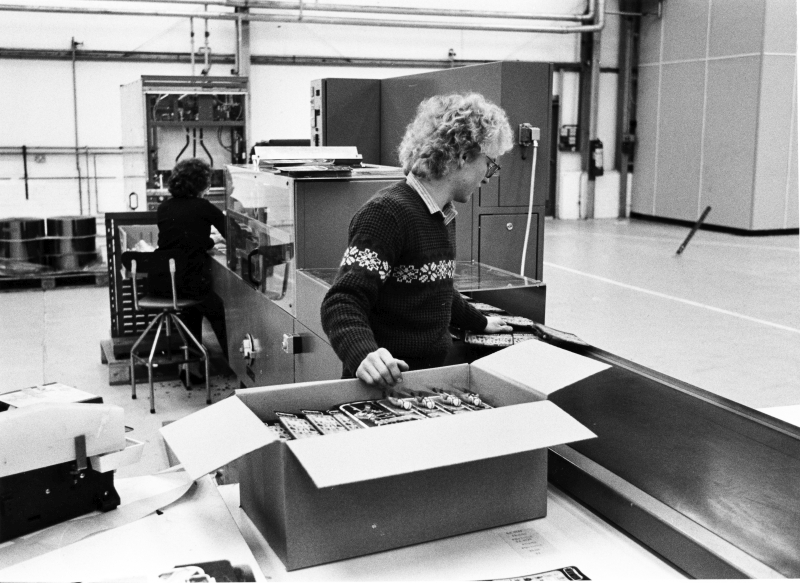
Palitoy's packaging facility in Ashby-de-la-Zouch during the 1970s
While Palitoy gave many of its products to the V&A Museum of Childhood in London as it closed down, a local legend of the "Palitoy Pit" of Star Wars figures and prototypes that were thrown away in Coalville persists. An unconfirmed site was set to be affected by the planned HS2 railway, which has since been scrapped. Local enthusiasts have been searching for the pit, while Australian Palitoy collectors have been attempting to preserve the company's advertising film prints. Star Wars figures that had been produced by Palitoy and sold for pocket money are auctioned for high prices. One Jawa figure was sold in 2023 for £21,000, excluding commission fees, having been made in Hong Kong with a vinyl cape in 1977/1978. Palitoy's chief designer, Bob Brechin, published his book "My Palitoy Story" in 2023 documenting the history of the toy company.
Palitoy's Hong Kong company was renamed Kenner Parker Toys (Hong Kong) Limited on October 23, 1985 and finally Tonka Kenner Parker Engineering (Hong Kong) Limited on May 6, 1988 and was dissolved on January 22, 1997. Manufacturing exports such as Palitoy Star Wars toys had boosted economic growth in Hong Kong, and many manufacturers took advantage of the mainland Chinese market in the 1980s and relocated production lines across the border to expand their operations; Forward Winsome's relocation and expansion began in 1979 and manufacturing in Hong Kong ceased around 1989. Around the same time, Kenner defaced and disposed of most of its Star Wars metal moulds in Hong Kong's Victoria Harbour, keeping only a few key moulds. Around 1990 and 1991, overstocked Star Wars figures were removed from Hong Kong warehouses and moved to Australia. Bearing "tri-logo" packaging, they were sold cheaply by Australian dealers and included unqiue packaged prototypes.
The general trend of toy manufacturing moved from the United Kingdom to Hong Kong and then to China's Guangdong province, which maintained consumer affordability but raised ethical concerns, including maltreatment and counterfeits. Star Wars remains one of a few franchises with products of long shelf lives for Forward Winsome, and many Star Wars toys are now produced by Hasbro through factories in China, with Forward Winsome among Hasbro's suppliers into the 2020s. Among the vendors is the Hong Kong–run Herald Metal and Plastic Works (興利五金塑膠廠) with its Dongguan factories, manufacturing Star Wars toys for Hasbro to be imported by the United States.
The Star Wars figures of the 1970s and 1980s inspired one of their players, Howard Chan, to establish Hot Toys, a Hong Kong toy manufacturer has been making Star Wars figures for Sideshow Collectibles since the 2010s. "Bootleg" Star Wars figures were also made in Hong Kong by so-called 山寨廠—small-scale family-run "shanzhai" factories such as Tomland Industries, including a Chewbacca figure resembling Palitoy's. In 2013, the Hong Kong manufacturer Awesome Toy was founded to make new figures based on vintage bootleg figures, combining a Tomland Chewbacca head with other body parts to create an original character for the local Skullmark brand.
Star Wars manufacturing was included in a 2014 exhibition curated by filmmaker Oxide Pang and a 2016 exhibition organized by the Hong Kong Trade Development Council Design Gallery on Hong Kong's plastic toy industry, as well as a larger 2017 exhibition in the city's Museum of History, with nearly a hundred life-sized First Order stormtrooper figures stationed outside to promote the event. In 2018, a Hong Kong Star Wars fan has been collecting Star Wars figures that were made in the city and showcased some of them at a toy fair. He had contacted a local manufacturer about whether they had any Star Wars toys or moulds remaining, but they replied that all the toys had been discarded and that the moulds had been returned to Kenner. Nevertheless, the fan felt that bringing Hong Kong–made Star Wars toys reflected his identity as a Hong Konger.
- Return of the Jedi Weekly 73
- Star Wars: The Action Figure Archive
- "Collections: Foreign Star Wars Collectibles" — The Lucasfilm Fan Club Magazine 5
- Star Wars: 1,000 Collectibles
- Star Wars Year By Year: A Visual History, New Edition
- Toy Empire: The British Force Behind Star Wars Toys
- "" — Star Wars Insider Special Edition 2022